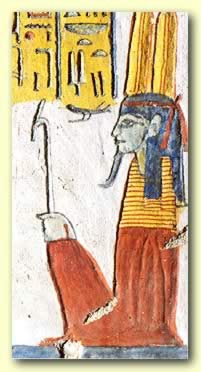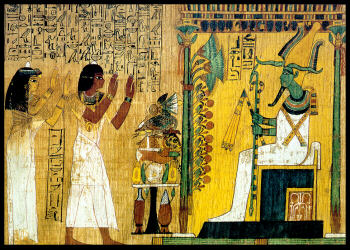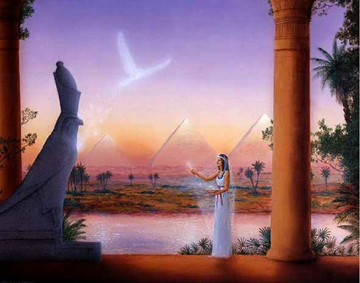Egyptian Temple Ritual -
Temple of Amen-Ra at Karnak
During the time of Amenhotep
III , approximately 3300 years ago
 |
|
Body erect, still kneeling, hands bent back as before but at an angle of 90 degrees.
Az a gam
look upon my offering
4. Hands flat as before, horizontal, but both pointing to the right.
see netee
here are two vases (gifts) : lit. "Come vases [plural]"
5.Arms flung heavenwards with hands straight out:
vaka zoom!
grant a blessing lit. Loose a blessing
6. Body erect, still kneeling, hands bent back as
before but at an angle of 90 degrees 
zama ad eiran fees
she, vola, has brought burning incense" lit. Incense, burning, prepared she brings.
7. Head bent, hands half forward, cup-shaped
Segoona deen
and this perfume"lit. perfume this
8. Head truned to the left, hands cup-shaped but resting against the body, palms up, with the palm of the right hand holding the back of the left hand, a gesture of completion and repose:
Zan na goos-tee eiran feen
accept these her offerings brought: lit Salute these her baskets of tribute made to bring.

A temple maiden would be a cup-bearer, tend to the lamps and arrange the vestments. She would also take part in the services and ceremonies. Here is an actual account, taken verbatim from a woman regressed to a lifetime in Egypt 3300 years ago:


pronounced: eest y
ah Vol'la.
|
"Lo! this is Vola. " or Here is Vola! |
"I am holding in each hand a sort of lamp with a pedestal
about a yard long. It is of wide, saucer-shape, with a white flame coming out at
the top. They are intended to fit into sockets with a metal ring, one on either
side of a curtain which conceals a central doorway at the end of a large hall.
It is the entrance to a hidden sanctuary, with rounded steps leading up to the
centre. The lights were intended to keep away evil spirits, and the incense to
keep pure the sanctuary itself.


a'zeen ta-ah la du-wan
a - b b-a -a g - f (musical notes)
"the most important festival of the year...for he was the most powerful of the Gods; the most feared, and yet one from whom the greatest blessing was sought and hoped for. The great Farang (Pharoh) is in this procession. I can see bulls with long, smooth horns, garlanded with flowers. I was a cup bearer in this service."
At one of our services, which took place once a year, a procession passed along the Avenue of Sphinxes, down one side, and back along the other side to the Temple. At each of the animals of stone the procession stopped, and we had to touch it with our palm-branches. The animals were not worshipped. The idea was that they were consecrated afresh each year to their duties as guardians of the Temple. This service was to remind them of their guardianship, and to pray that no evil spirits would pass them and so gain admission to the Temple.
Other Temple Gestures
Hands outstretched in curves, palms upwards head uplifted
Head lowered in humility, swaying slightly from side to side with movements symbolic of unworthiness
Hands drawn in , palms downwards, fingers extended- lateral gesticulation as in protesting unworthiness
Head raised again to heaven, arms flung upward in adoration and entreaty
Repeat: Head lowered in humility, swaying slightly from side to side with movements symbolic of unworthiness, hands and arms showing contrition
Head erect, arms forward in mute appeal
Head on table (or floor, if standing) face down- silent meditation, head resting in hands.
My arms are bare to the shoulders, and I am wearing a pale muslin robe, crossed and pleated over the breast, tightly and beautifully done. I have also a straight undergarment from my neck to my feet, fitting tightly to the body. The outer dress is folded over the front at the waist and hangs down.
I have sandals on my feet, bracelets on my arms; and a broad flat necklace from the shoulder to the collarbone: also a curious head dress like a halo round the forehead, fastened round horizontally, with another band going over the top from front to back. My hair is thick, not curled, and comes down straight to the shoulders, with round discs hanging at the sides of the headdress. Very lovely effect, although artificial, with painted eyebrows, full lips, and painted eyes : it feels my own self.
| The god, in the form of a statue, was housed in a shrine, the naos,
which was built of stone or wood and was located in the innermost
chamber of the temple. The statue could be made of stone, gold or gilded
wood, inlaid with semi-precious stones. Often it was less than lifesized.
It was not regarded as an idol, but as the receptacle of the deity´s ka. Receiving a blessing from Amun-ra
|
